Share this
How Product Sampling Can Drive Ecommerce Sales Success
by Rin Mosher on Apr. 17, 2024
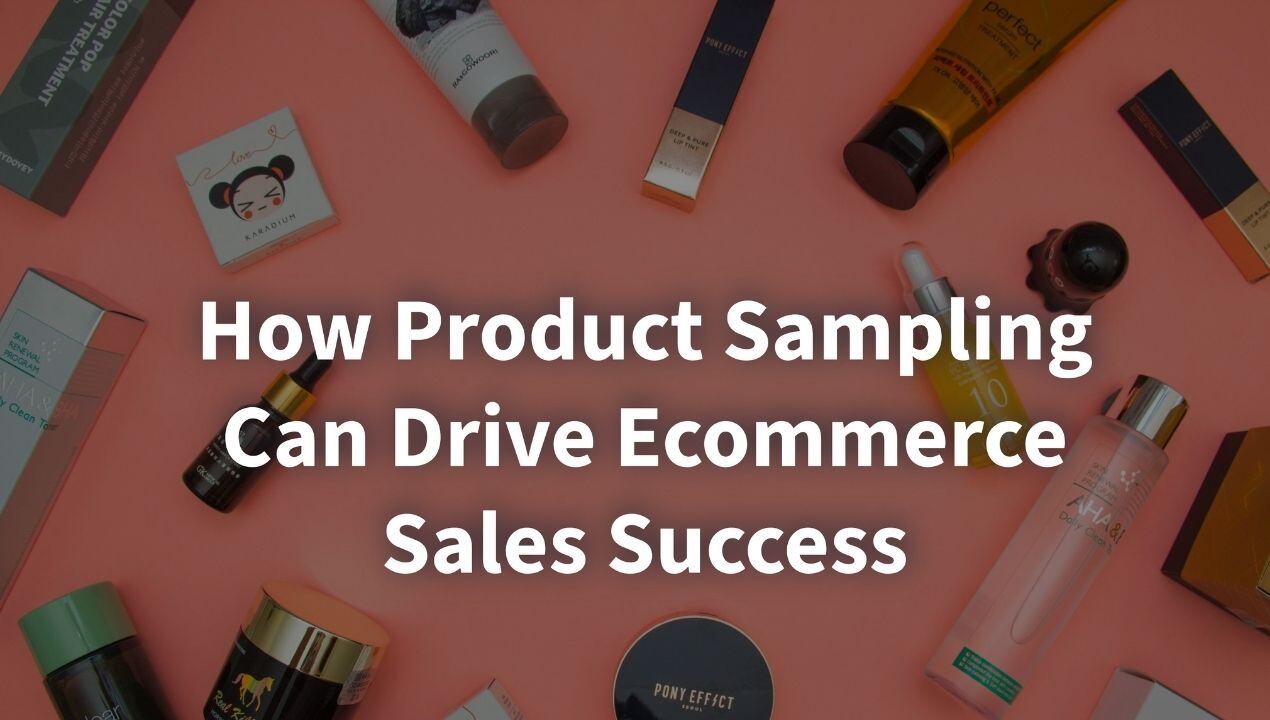
Is the secret to boosting your ecommerce sales giving products away for free? It may seem counterintuitive, but product sampling can be a great way to encourage purchases and establish strong customer relationships. It’s becoming especially valuable in the highly competitive ecommerce space. From mitigating returns to driving product exposure and development, there are plenty of positive outcomes to reap by implementing a strong product sampling strategy.
In this article, we explore why product sampling works, the different product sampling strategies you can use, how some popular ecommerce businesses are using this tactic to their advantage, and how you can launch your own successful product sampling campaign.
What Is Product Sampling?
Product sampling is a marketing strategy in which businesses offer small quantities of their product for consumers to try before they commit to purchasing the full-size version. The tactic dates back decades, having originally been used in brick-and-mortar contexts like grocery stores and malls. Ecommerce stores are now experimenting with product sampling as a way to entice online shoppers and boost sales.
The goal of product sampling is to give customers a taste, literally or figuratively, of what a product or brand has to offer. By providing a sample of a product at no or low cost, businesses can create a positive experience for consumers and ultimately encourage them to make a purchase. This strategy is especially popular when introducing and promoting new or niche products.
Two Forms of Product Sampling
Direct product sampling is the strategy traditionally used in physical retail settings. Brands often set up booths to provide passing customers with samples at the grocery store, for example. Some pop-up stands leverage samples to incentivize newsletter sign ups and contest entries, while many boutique stores give customers freebies with purchases over a minimum total. In any case, this approach can be an effective means of getting exposure for new and old products in a personal and engaging way.
Indirect product sampling has become more prevalent in recent years with the rise of ecommerce and online shopping. It involves sending samples to customers via mail either on their own or as an add-on to online purchases. This allows companies to achieve similar or greater reach and exposure, although in a way that’s slightly less personal than traditional product sampling.
Still, indirect product sampling provides businesses with an opportunity to connect with customers through experiential marketing. The main difference is that this method is self-executed, allowing sample recipients to engage in the product discovery process on their own initiative and without any external distractions.
Types of Ecommerce Product Sampling Campaigns
Sampling in ecommerce works differently than it does in brick-and-mortar environments, but that doesn't mean it has to be any less effective. In fact, the sample-by-mail approach gives businesses an abundance of opportunities to create new and unique experiences for customers. Here are just a few product sampling methods used by ecommerce brands today:
Free Product Sample Add-Ons
With this tactic, customers have the option to add a bonus product sample to their online purchase during checkout. This strategy is effective in both encouraging larger average order values and reducing cart abandonment rates. When shoppers know they have something extra to gain by buying from an ecommerce store, they’re much more likely to do so.
Sephora is one example of a brand that uses add-ons to its advantage really well. Customers can order from a consistently updated list of samples for everything the beauty retailer offers, from hair to skincare.
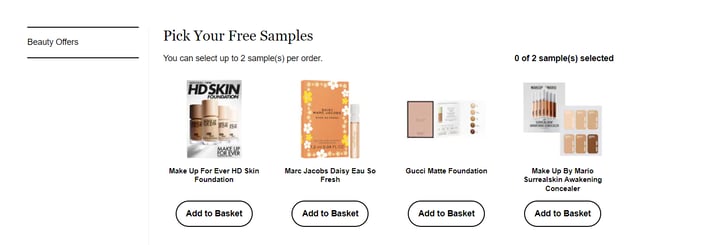
Transactional Product Sample Add-Ons
Samples are always given with a goal. That’s why many businesses take a transactional approach to ensure every ‘free’ product they offer delivers some sort of return. To use Sephora as an example once more, the beauty brand incentivizes large average order values by rewarding buyers with exclusive samples once they reach a certain purchase minimum.
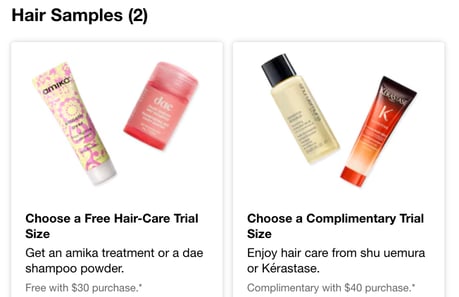
Surprise Product Samples
Surprise samples are a thoughtful way to show customers that they’re valued. Very few ecommerce stores take this approach, so even small goodies have the potential to create a positive lasting impression.
As the name suggests, surprise product samples are sent without a customer’s prior knowledge. Usually included alongside orders, they’re an unexpected bonus that compliments and enhances the unboxing experience.
Beyond brand loyalty, surprise samples also create an opportunity to introduce customers to products they might not have tried before. Data on past purchase history and interests can be used to inform personalized product sample selections that are more relevant to the customer and therefore more likely to be purchased down the road.
Product Sampler Sets
Sampler sets are special kits available for purchase that contain minified versions of multiple products, often ones in the same collection or category. Customers can order them to get a feel for different options or formulas before committing to purchasing a full-size product.
Sampler sets are most commonly used in the beauty industry, where brands curate collections of their most popular perfumes, creams, serums, etc. But there are applications in other markets as well, such as food and supplements. The honey company Sun River Honey, for example, offers a Deluxe Mini Sampler Gift Set complete with eight mini jars from its variety of flavor-infused products.
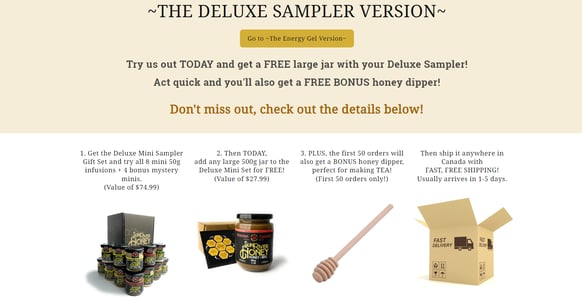
Product Sampling Examples From Birchbox
Despite being a newer strategy, the act of offering free samples with ecommerce orders has seen significant success over recent years. Brandshare reports that 97% of consumers try free samples, and of those people, 14% to 33% end up converting into paying customers.
There are now even companies that exist for the core purpose of providing by-mail product sampling. Birchbox is a pioneer of the space—it was founded in 2010 and has since served more than 800,000 people across North America. Customers of this subscription box receive monthly packages containing a hand-picked curation of product samples from beauty brands.
It’s estimated that 50 percent of Birchbox subscribers end up buying a full-sized product on its online store at some point. In one case, cosmetics brand Stila reported 11.2% of people who received their eyeshadow palette sample through Birchbox ended up purchasing the full product.
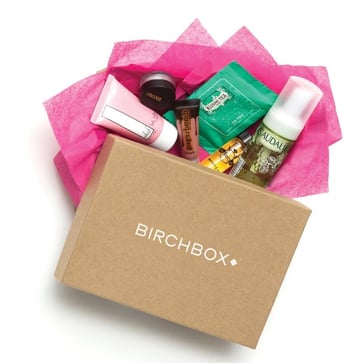
Where Product Sampling Can Pay Off
Product sampling campaigns are sometimes misperceived as an unnecessary use of time and money. Why give things away for free when you can just focus on getting sales the old-fashioned way? The answer is complicated, but extremely compelling, as there’s a lot to gain by taking the initiative to offer product samples. The benefits of product sampling include not only driving sales, but also increasing brand loyalty, improving conversion rates, and reducing reverse logistics costs.
Addressing Buyer Hesitancy
Things like size, texture, color, taste, and scent are hard to gauge when shopping online. Customers don’t have the chance to physically touch items unless and until they place an order. This creates an additional layer of hesitancy in the buyer’s journey which can ultimately impact sales.
Samples give consumers just enough of a preview to decide whether a product is the right fit for them. If they end up enjoying the product, they’ll feel much more confident when making a purchase.
The try-before-you-buy methodology is particularly valuable in segments of ecommerce that see high order return rates. Introducing prospective buyers to a product series can also help reduce hesitancy to purchase higher priced items.
Creating Demand for Full-Sized Products
Product sampling can increase product demand in two ways. The first is through exposure. Businesses often use samples to introduce their offerings to as many consumers as possible, even those who weren’t previously considering purchasing the particular products being sampled at all. If users like a product, they're likely to order it themselves and may even recommend it to their friends and family.
The second way product sampling creates demand is through scarcity and hype. Samples may be leveraged as a means of promoting limited edition products; major perfume brands have long taken this approach to experiential marketing to give potential buyers a "sneak peek" of new fragrances and build excitement to purchase before they are officially released.
Creating Brand Loyalty
Repeat customers are direct-to-consumer brands’ biggest drivers of revenue, representing roughly 65% of total sales. That makes sense when research suggests businesses have a 60% to 70% chance of selling to individuals who have bought from them before. Converting a new prospect into a customer requires a lot more work and investment.
Free gifts offer an easy way to make people feel appreciated without much additional effort. Samples can be added to existing orders as a small 'thank you' for their purchase, or sent out separately to encourage them to come back and try more products.
Even small samples show a business’ thoughtfulness for its customers and, likewise, a willingness to provide them with experiences that go above and beyond the status quo. The positive associations this creates can lead to increased brand loyalty and word-of-mouth marketing.
Trialing New Products
Bringing new products to market is always challenging, but can prove especially challenging in ecommerce. Customer reception is hard to accurately predict during preliminary research, and it's typically only after launch that a business gets a full picture of what people think. This can be risky for companies, especially smaller ones with limited resources.
Product sampling can come in handy here by acting as an opportunity to field test new products and gauge customer interest. A business might send select formulas to a portion of their email list, for example. This allows them to get feedback from a smaller group within their target audience before fully investing in marketing and production costs.
Acquiring Market and Product Insight
Product sampling can be used as a more cost-effective way of experimenting for businesses that want to improve their resonance with customers. The observations made during a product sampling campaign can highlight areas for improvement alongside potential opportunities in everything from product development to marketing. For instance, if one particular variety of a sample is chosen overwhelmingly more than others, that would be a good reason to explore similar offerings. Similarly, samples rarely selected by customers might need to be revamped or phased out.
Encouraging User-Generated Content (UGC)
The world of social media offers a great marketing opportunity for ecommerce businesses to get positive exposure for their brand and products. User-generated content (UGC) refers to content that is organically made by real-life consumers. It is typically produced on a customer’s own initiative, but UGC can be encouraged through product sampling as well.
For example, you might use the excitement of an unexpected free sample to encourage consumers to post about or review products online. This is a low-cost but incredibly effective means of promoting engagement among existing customers and new customers alike. User-generated content also provides valuable social proof for your products, and it adds a trustworthy human element to your brand that resonates with consumers.
Incentivizing Engagement/Specific Actions
To expand upon the last section, UGC isn’t the only type of measurable return you can earn with a freebie. Positive product reviews, referrals, and more are all easier to acquire with the right incentive.
Consider offering complimentary product samples or full-sized products in exchange for something of equal value to your business. There are plenty of ways to go about doing so, from samples for positive reviews to refer-a-friend programs that reward both referrers and new customers with free products.
You can also use sample kits as a prize for contests and giveaways on social media platforms. Again, the expense of offering that free product can pay off multiple times over in the form of online engagement, brand loyalty, or progress towards any other business goal, for that matter.
Minimizing Return Rates
With the average ecommerce return rate being 11% higher than that for products bought in-store, every online business that wants to compete with physical establishments has a reason to care about order satisfaction.
Product sampling offers an easy and cost-effective way to mitigate misaligned expectations by giving consumers the chance to touch, feel, and use products before committing any of their money to a full-sized order. While there’s a small expense associated with offering samples for free, it’s often much less than the cumulative costs of return shipping, product inspection, restocking, and the other fees associated with reverse logistics.
How to Find Success With Product Sampling
Product sampling is far from foolproof. It can be easy to waste time and budget on this tactic when operating without a proper strategy in place. Offering samples as an ecommerce business can also prove to be very complicated, requiring additional considerations in order to be successful. Keep the following tips in mind as you prepare a product sampling campaign for the first time.
Leverage Customer Data
From advertising to customer service, customer data provides invaluable insight that can be applied to a variety of business use cases. Product sampling programs are no different. The best way to successfully plan what samples to send, when, and how is by using the data your business has accumulated on your existing customers and their buying habits. The better aligned those variables are with a target customer, the more effective of an impact your sampling efforts will have.
Consumers are used to receiving generic samples of whatever product a company is promoting at a given time. When they’re given something specific to their personal needs – like color-protectant shampoo for someone who frequently purchases hair dye – that gift is a lot more useful and meaningful, thereby encouraging loyalty and future purchases.
Be Mindful of Seasonality
As is seen with regular full-sized products, seasonality can significantly impact consumer behavior. For instance, interest in hand creams and moisturizers tends to spike during colder months of the year. Keep this in mind to ensure the samples you send are as relevant and valuable to recipients as possible.
Consider Cost
Cost is perhaps the biggest pain point ecommerce businesses experience when considering a product sampling campaign. It costs money to give items away for free, and even paid sample kits can add packaging and production expenses to your bottom line. The key to making this a cost-effective strategy is knowing exactly what you hope to achieve and how much the completion of the goal is worth to your business.
For instance, sending unnecessarily large samples to customers in exchange for smaller, less-valuable actions wouldn’t be sustainable. Similarly, the brand awareness created through a sampling campaign can only take up so much time and money before it becomes cost-prohibitive.
Consider what your business is realistically capable of doing in terms of campaign size and scope. It’s generally more cost-effective to offer free products that are lightweight and easy to ship. On that point, you should also make sure you have the resources to keep up with a product sampling program. Can your business’s fulfillment operations accommodate an increase in demand, or will that require additional investments in infrastructure?
Ensure Your Fulfillment Can Keep Up
Ecommerce sampling campaigns are only successful with a robust fulfillment system in place. These projects require the same degree of care and resources as regular order picking, packing, and shipping, if not more so, to maintain order accuracy. You’ll need to work with your ecommerce fulfillment center to plan a warehouse project and have answers to several questions.
For example, how will samples be included with orders? In the same shipping box, or separately? Will your in-house fulfillment team be able to handle the additional workload, or will you need to hire temporary help for the duration of the campaign?
Weaving samples into an existing workflow involves a lot of moving parts and the potential for errors. Staff need to be trained on how to properly insert samples, keep track of inventory, and ensure the correct samples are being sent to the right customers. If you don't believe you have the infrastructure in place to do this on your own, partnering with a third-party logistics (3PL) company is the best option to ensure success.
A 3PL company can handle the entire fulfillment process for you, from storing your samples to packaging and shipping them out to customers. As a long-term partner, you'll be able to count on them for support beyond just your product sampling campaign.
Just remember that not all service providers are made equal. You’ll want to work with a 3PL that can not only meet its core duties of picking and packing but also offer high-quality care. This means storing products in safe conditions, arranging warehouse projects like kitting and bundling for products requiring them, and managing inventory to never run short of the right samples.
Product sampling can be a highly effective marketing strategy for driving brand loyalty and increasing sales. However, it requires careful planning and execution to ensure success. Partnering with a reliable third-party logistics (3PL) company like Shipfusion can take the hassle out of logistics for you.
Use our robust technology and expertise to seamlessly ship products, track inventory levels, and provide real-time updates to your customers. A seamless sampling campaign that helps to grow your ecommerce business is within reach—and it starts with 3PL expertise. Contact our fulfillment team today to learn more about how we can help make your product sampling strategy while scaling your business success.
Share this
You May Also Like
These Related Articles
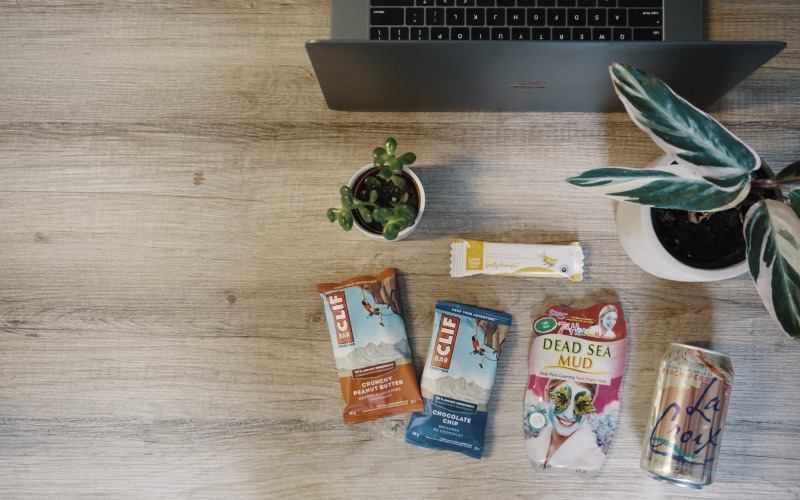
Product Sampling Meets Smart Sample Fulfillment Services

How to Increase Average Order Value With Real-World Examples
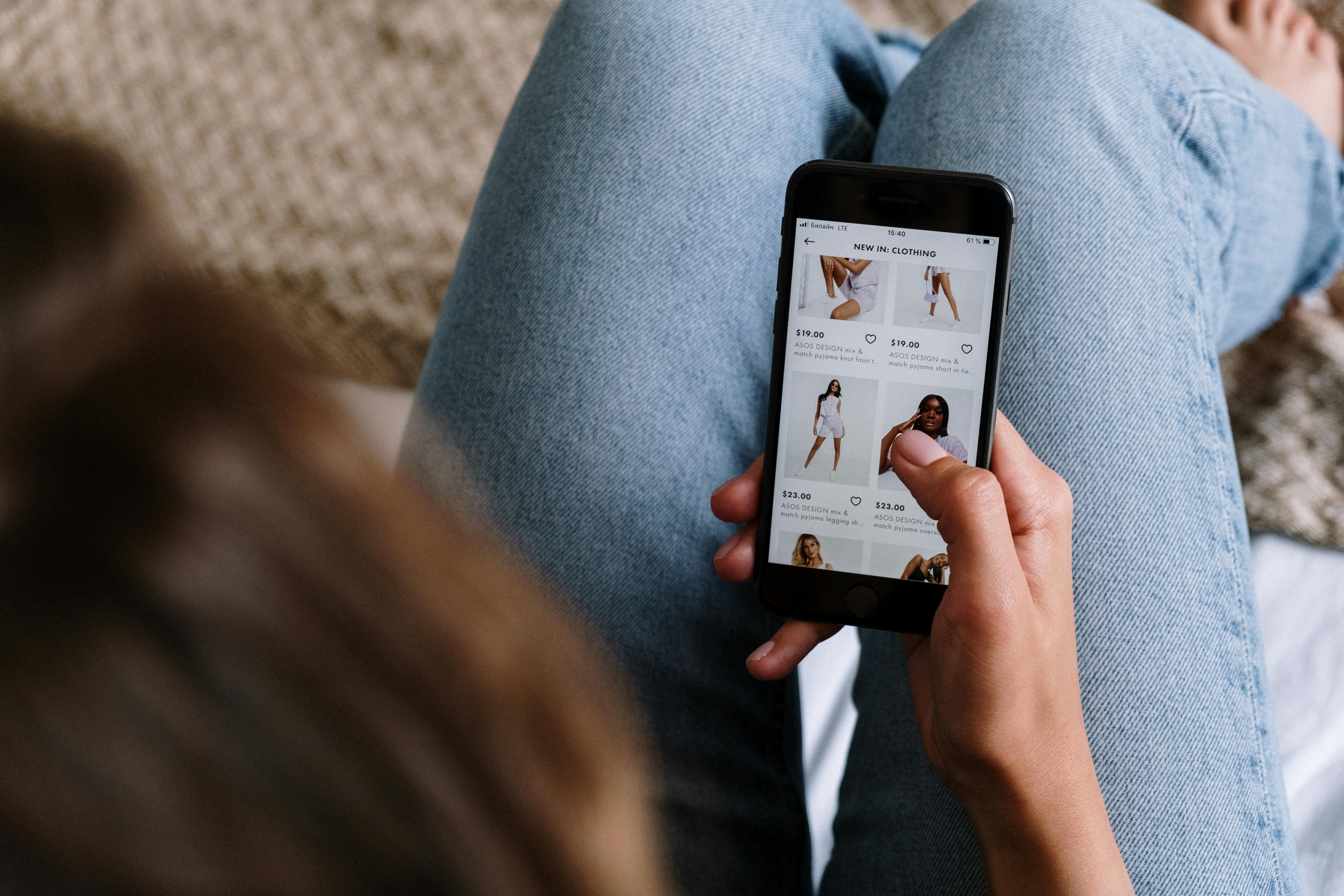
The Best Social Commerce Platforms In 2024 with Benchmarks
- April 2025 (9)
- March 2025 (26)
- February 2025 (26)
- January 2025 (37)
- December 2024 (16)
- November 2024 (23)
- October 2024 (22)
- September 2024 (27)
- August 2024 (9)
- July 2024 (8)
- June 2024 (5)
- May 2024 (8)
- April 2024 (8)
- March 2024 (6)
- February 2024 (6)
- January 2024 (5)
- December 2023 (3)
- November 2023 (3)
- October 2023 (5)
- September 2023 (4)
- August 2023 (2)
- July 2023 (1)
- June 2023 (4)
- March 2023 (2)
- October 2022 (1)
- September 2022 (5)
- August 2022 (4)
- July 2022 (7)
- June 2022 (4)
- May 2022 (4)
- April 2022 (6)
- March 2022 (2)
- February 2022 (1)
- January 2022 (3)
- December 2021 (2)
- November 2021 (4)
- October 2021 (2)
- September 2021 (5)
- August 2021 (4)
- July 2021 (4)
- June 2021 (3)
- May 2021 (2)
- April 2021 (3)
- March 2021 (3)
- February 2021 (3)
- January 2021 (2)
- December 2020 (4)
- November 2020 (2)
- October 2020 (4)
- September 2020 (2)
- July 2020 (5)
- June 2020 (4)
- May 2020 (2)
- April 2020 (2)
- March 2020 (4)
- February 2020 (1)
- December 2019 (1)
- May 2018 (1)
- March 2018 (2)
- February 2018 (3)
- January 2018 (3)
- November 2017 (3)
- July 2017 (4)
- March 2017 (3)
- February 2017 (5)
- January 2017 (3)
- December 2016 (4)
- November 2016 (6)
- October 2016 (6)
- October 2015 (1)
- September 2015 (1)
- June 2015 (3)
- May 2015 (3)
- August 2014 (1)
- July 2014 (1)
- March 2014 (1)
- February 2014 (1)